
Last week, two of the UK's most famous sea stacks were hosts to two remarkable ascents. In Orkney, 8 year-old Edward Mills became the youngest person to free the Old Man of Hoy (137m) - raising over £26,000 and counting for Climbers Against Cancer in the process - while in Sutherland, 72 year-old Tony Stott achieved a goal that had eluded him for 40 years: to climb the Old Man of Stoer (60m). 80 miles in distance and 64 years in age apart, these two climbers proved in the same week that age truly is just a number - a life lesson taught by two very craggy Old Men.
Edward's ascent and the story behind his climb have captured the hearts of the nation this week, with countless mainstream news reports online and on the TV and radio. His coaches Cailean Harker and Ben West sent in a short report about their day. UKC also sent questions to Edward and his mum, and to Tony about his adventure, which follows the report below.
'Hi I am Edward. I am 8 years old and I climbed this for my Mum.'
Edward first had the idea of climbing the Old Man 3 years ago when he did a school project about his future ambitions. In this he drew a picture of the Old Man, researched the height and wondered if it was possible for him to climb. It wasn't until he read about Ollie Buckle, who climbed it when he was 10, that Edward realised he could climb it and that he may be able to do it before he was 10. Edward's dad broached the idea with us, while Edward was attending our coaching sessions in Bristol, to see if the climb was feasible and a plan was formed.
For as long as Edward can remember, his Mum, Bekki has been living with breast cancer. Over the last year or so Bekki's cancer has spread to her liver and spine, and although she has has been in considerable pain, that has not prevented her remaining behind Edward with love and support and being there to watch him climb. This love and support has fuelled his ambition to climb the Old Man as well as to raise money for the charity Climbers Against Cancer.
In the last few years of working with Edward it was clear that he had the skills required to climb the Old Man of Hoy. His ability to problem solve on our sessions were amazing especially when they involved bridging, mantles, lay backing and palming; all vital techniques for climbing the Old Man of Hoy.
Having climbed indoors since the age of 2, Edward knew he needed to gain some outdoor climbing experience. He was fortunate enough to have the support of Climb Scotland and other climbing friends from the local area who took him out to practise on the sea cliffs near his home in Caithness.
Kitting up at the base Edward looked apprehensive of what lay ahead, but he was confident he could climb to the top. After a quick game of "rock, paper, scissors" to decide who would have the first lead, we started up the route alternating leads with Edward seconding in-between. The first pitch went without too much difficulty and despite his nerves Edward was climbing well. We all arrived at the top of pitch one to find the second from the party above still there. We had concerns about the crux pitch. We waited on the ledge for 30 minutes for the guys above to finish the pitch before we could continue.
The crux pitch involves a 3 metre downclimb and a fairly unprotected traverse, before getting involved with a technical, steep and sandy corner. Protecting Edward on this section wasn't straightforward. We opted to belay him from both sides to avoid a big swing if he were to fall. Once he had navigated the traverse he found himself at the base of the "Great Crack". Edward had to use all of his climbing skills to navigate the chimney. Some of the moves he was doing wouldn't be out of place in a boulder World Cup. The exposure and the difficulty of getting out of the chimney made Edward question his ability to succeed on the route. This pitch is significantly harder than any others and Edward's height made the moves even more of a challenge; at one point he couldn't reach between the holds and had to smear up the groove. We knew that if he succeeded here he could reach the summit. With some verbal encouragement and time to gather his thoughts he regained his confidence and pulled out of the crack and climbed to the belay.
On the next two pitches the climbing was more straightforward. The main challenge to contend with was the fulmars and other wildlife on the route. Fortunately we made it to the bottom of the last pitch clean and vomit free. We even sat next to some puffins at the top of pitch four while we ate some chocolate buttons. The final pitches climb a big, steep, open-booked corner on immaculate rock with nothing but air below your feet. Edward coped with this exposure bravely and topped out into the sunshine having achieved his dream.
On the summit we left a small plaque as a memento and Edward wrote a personal message in the note book: "Hi I am Edward. I am 8 years old and I climbed this for my Mum."
Edward's mum Bekki had boarded a ferry from Stromness to Scrabster, which passes The Old Man of Hoy, with the intention of seeing him on the climb. As it turned out the 30 minute delay at the start of pitch two resulted in the ferry passing shortly after Edward signed the notebook and he was able to wave to his Mum from the summit. This meant the world to Bekki and made for a very poignant moment.
Despite reaching the top we still had the small matter of the descent. This involves three huge abseils, which are not to be underestimated, down the 137m face. Edward abseiled alongside one of us, passing all the climbing we had just done. The final abseil is a 50m free hanging trip through space before finally arriving safely on the ground.
Once Edward was back on the headland, after a long and tiring scramble out, he phoned his mum. She was so proud. On the walk back to the car Edward was exhausted, but in the presence of the setting sun he had time to contemplate what had been achieved. It may take some time to sink in.
Edward has a Just Giving page to raise money for Climbers Against Cancer which has already raised over £30,000 if you would like to donate then visit his fundraising page.
UKC sent Edward some questions about his big day out...
How did you feel before the climb on the day? Were you nervous?
Before the climb I wasn't really thinking about it, not until the day before when I started to wonder what it would be like. I was nervous and excited.
What did you think when you first saw the Old Man on your arrival?
We had to walk in for an hour from the car across the moor. It was lucky because there were no midges and no boggy bits. We just went up one hill and then down. When we got the there it was bigger than I thought it would be. We could see it getting closer and getting bigger and from the bottom it is really big.
Which parts did you find the hardest?
The hardest part was when I was in the chimney. I couldn't see anything but the wall and I needed a wee and I didn't know what to do. To climb out of the chimney I had to reach out with my hand and I couldn't see the move, I just had to feel for it. That was the hardest bit. Ben talked to me and he kept telling me I could do it. And I had a wee and I felt better.
How did it feel to top out?
Topping out was really good. Normally when you top out you put your two hands to the top hold and then you come down again but this was like a part of the climb, I had to pull myself up on to the top and then stand up. I really liked being able to stand up and look all around. I liked the view of the sea best.
You've been on the TV and all over the internet - how do you feel about that?
It was exciting to be on the TV, on the news, my grandma and grandad saw me and they really liked it. My mum doesn't let me look at the internet or facebook so I haven't seen that. I looked at the Instagram pictures. I like looking at other people climbing on Instagram so it was cool that other people could see me. The best bit is climbing. I prefer climbing to being on TV.
Did you expect so much interest from people?
I didn't think about lots of people seeing it but we had seen it when Ollie Buckle did it and I wanted to beat him and be the youngest person.
Do you think you'll do more of this kind of challenge?
Yes, I want to climb more big sea stacks.
Edward's Mum Bekki commented:
"For me, seeing Edward accomplish something so phenomenal was amazing. We have known that Edward has a passion and a talent for climbing for a while now and watching him do competitions or experience different types of rock climbing is always bittersweet. I love it, I love watching him, I love watching climbing in general, the aesthetics of the movement is beautiful and I am a big outdoors fan. But at the back of my mind is always, will this be the last time? It makes me so sad that I can't go on this journey with him. I think Edward is going to have a life filled with adventures and I hope that I have done everything I can as a mother in the short time I have had with him to set him up to work hard, persevere and enjoy the moments."
Edward was recently featured in our UKC Humans of Climbing series on social media:
We also sent some questions to Tony to find out how his day went a bit further south on the Old Man of Stoer. Tony was accompanied by mountaineering instructor Karen McIntyre on the climb, while his wife Denise watched.
'The "if only's" and various regrets became a bit painful to review and loads of unfinished business floated to the surface. Top of the pile was The Old Man of Stoer - and the question "what are you going to do about it?"'
Tell us a bit about your climbing story before the Old Man.
I was born in Wakefield, Yorkshire and raised on a diet of gardening and family walks in the Dales. But at college I met a bad bunch who got me into climbing A3's at Malham Cove, Goredale Scar and Kilnsey. In 1968 we had a winter holiday in Scotland and did the big ridges on Nevis followed by Point Five. I was hooked on the Scottish winter, got a job with ICI and moved North to the Ayrshire coast. After a few years of learning, largely by experience and hard knocks I graduated to bigger stuff and in 1974 we had a very productive year; climbed the Old Man of Hoy, Am Buachaille in Sandwood bay and generally got organised for a first foreign trip. Over the Christmas period we climbed the Heim Glacier route on Kilimanjaro, made the second ascent of Point John Couloir and a direct route on the South Face of Nelion on Mount Kenya. The next few years were more about carving out a career, getting married and buying a house with the odd trip to the alps thrown in but with the encouragement of a few colleagues I completed the Munro tops.
From 1981 onwards it was a diet of work, cycling in summer and climbing in winter with a lot of international travel, two trips to the Himalayas and one to the Atlas - trekking not climbing. After a couple of years based in The Netherlands I stopped full time working in 2001; in 2003 we moved house to Speyside. We are committed to staying here, my wife is a Scot so I consider myself to be from Scotland.
What prevented you from trying the climb for those 40 years?
Time has been a big issue, long hours at work, the commute to and from meaning that most of the week is a write off leaving whatever you can cram into a weekend. The local hill in Aberdeen is Lochnagar and I got to know it quite well. I also joined the local cycling club and did time trials and the odd race.
It took a while to wind down and relax when we moved to Speyside and all of a sudden old friends and colleagues were missing. A combination of heart disease, cancer and dementia had decimated the ranks leaving a very select few. In the process of discovering what happened to whom and when the "if only's" and various regrets became a bit painful to review and loads of unfinished business floated to the surface. Top of the pile was The Old Man of Stoer - and the question "what are you going to do about it?"
Did you do any specific training/preparation for the climb?
I am in reasonable shape, I spend a day a week on the hills and hit the local sports hall for circuit training three times a week plus spinning classes when I have the puff. I do running, mountain biking, road cycling and winter climbing - mainly easier grades, solo. However, I did promise Karen I would do a session a week at the Inverness climbing wall as preparation - sorry to say I failed completely on that one.
Why Karen? We have known each other for about 5 years and met at a drytooling comp at the Ice Factor. We share a passion for woodwork, art and climbing and I have an old-fashioned approach in that I will only climb with someone I know and trust. In the last 20 years I have compromised this only once and still regret it. The date for the climb was set in March and we were fortunate in having great weather on the day.
Tell us about the climb!
My biggest concern was the need to swim the channel between mainland and the Old Man. We asked at the climbing shop in Ullapool on the way north and they took great delight in telling us there was no rope and we had a swim coming up. When we got there a rope was in place for which both of us will be forever grateful. My wife Denise did the driving for us and we planned to do the climb and return home that night. Denise also acted as cameraman from the mainland side.
The descent from the top to the base of the mainland is loose and a bit of a sod - we used trainers, doing it in rock boots would not have been a good idea. We arrived about low tide and some of the guidebooks mention a boulder hopping route at low tide to avoid the swim but we couldn't see it. Sometime later we read/remembered a traverse line around the seaward side of the stack to miss the greasy traverse but by then it was too late - we'd done it. The landward side is higher than the stack side so its a fast zip across and an easy landing.
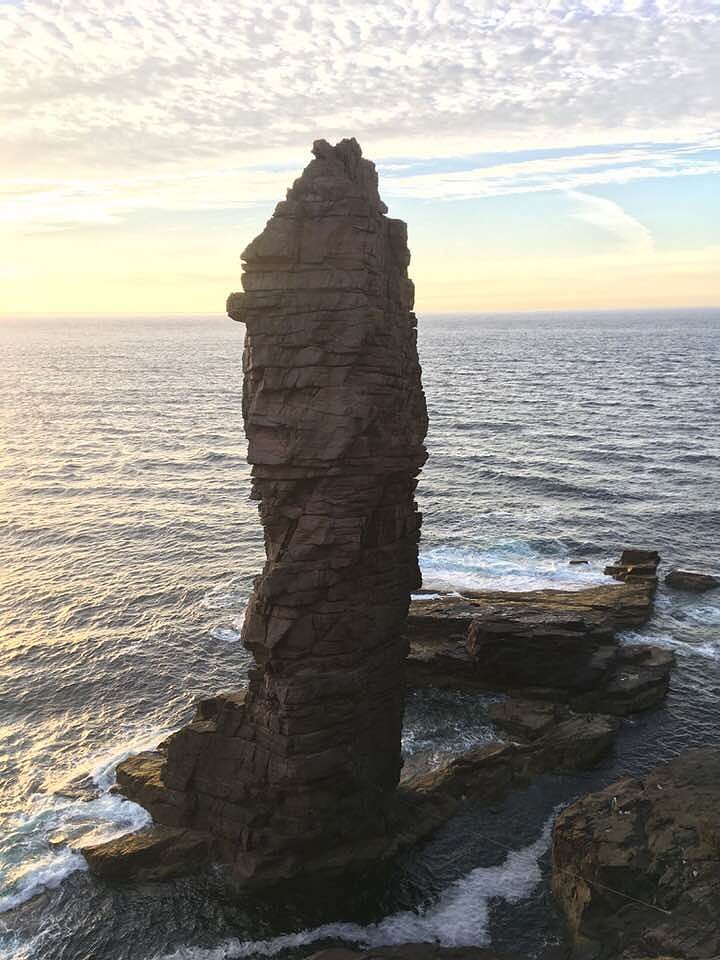
We agreed Karen would lead the lot and organised the kit accordingly. The first pitch is a thin and greasy traverse in the shade with a gentle cooling breeze and all communications swamped out by the sound of the sea. I should say that old habits die hard and I have no concerns about pulling on well placed gear if I feel the need - on the greasy traverse I felt the need. The third pitch was back on the landward side but the cave belay was brilliant and out of the wind. Then on the exposed landward side Karen headed for the top and after negotiations with a fulmar, topped out around 7 in the evening.
Karen has a completely different climbing style to me, she is flexible and will bridge chimneys on the outside; I am not flexible and get into maximum contact with mother earth at every opportunity. The rock was a delight but the top 30 feet are an overhang, was it easier to the right? That would have meant getting up close and personal with the resident fulmar which was not fair on the bird and we coped with the alternative. The abseil descent went without a hitch and we completed it in two stages - we had 50 metre ropes and they were too short to do it in one.
A comment on my climbing partner; Karen did a fantastic job. Most of the time we couldn't see each other since the route wanders around the SE arête and the comms were difficult due to background noise so she hadn't a clue what I was doing. It would be easy to say she would find it straightforward when she was climbing about 3 grades below her regular level, but having the stress of leading it all, her first sea stack and the first time we had climbed outside together - she's the hero of the day.
I'm really pleased I did it, massive buzz but I have revisited my climbing ability and that was about my limit, on the top pitch the arm strength was tested and the forearms were well pumped - I really did need the once a week trip to the wall. Mentally, no problem, even the abseil was fine - looking down at 150 feet between your bum and the sea then going free of the rock in a couple of places is not something I do every week. We had an audience of tourists, walkers, runners and photographers for the whole thing.
Any advice for other 72 year olds?
Do it; and do it now. If you need assistance from a professional then throw some money at it but do it while you still believe you can.
Any advice for young Edward Mills?
Denise and I don't have any kids and I don't know you Edward, so this is a pitch in the dark. Your next 10 years + are all about education and new skills - work hard on that - AND find the time to keep your fitness.
Do you have any other adventurous goals?
We are joining a friend in France for his 60th birthday and will cycle Mont Ventoux this autumn. I now have a wish list of classic climbs that includes Cumming/Crofton on Mitre Ridge; South Ridge Direct in Arran for about the 10th time and Smith's route on Gardyloo Buttress in winter. I am in negotiations with two friends on one last big trip for next year.
The final comment I would make is that without the active support of Denise over many years I would not be doing any of this stuff; she is in remission from cancer and bloody marvellous. We celebrate our 40th wedding anniversary in November.
- SKILLS: Top Tips for Learning to Sport Climb Outdoors 22 Apr
- INTERVIEW: Albert Ok - The Speed Climbing Coach with a Global Athlete Team 17 Apr
- SKILLS: Top 10 Tips for Making the Move from Indoor to Outdoor Bouldering 24 Jan
- ARTICLE: International Mountain Day 2023 - Mountains & Climate Science at COP28 11 Dec, 2023
- ARTICLE: Did Downclimbing Apes help Evolve our Ultra-Mobile Human Arms? 5 Dec, 2023
- ARTICLE: Dàna - Scotland's Wild Places: Scottish Climbing on the BBC 10 Nov, 2023
- INTERVIEW: Loki's Mischief: Leo Houlding on his Return to Mount Asgard 23 Oct, 2023
- INTERVIEW: BMC CEO Paul Davies on GB Climbing 24 Aug, 2023
- ARTICLE: Paris 2024 Olympic Games: Sport Climbing Qualification and Scoring Explainer 26 Jul, 2023
- INTERVIEW: Malcolm Bass on Life after Stroke 8 Jun, 2023



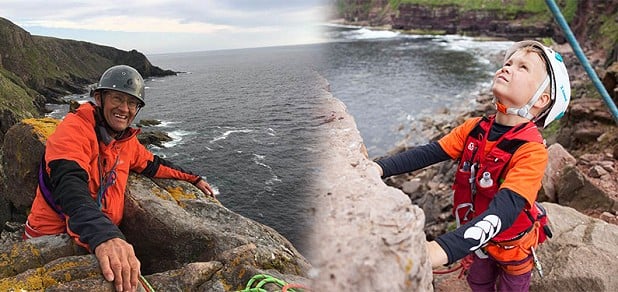
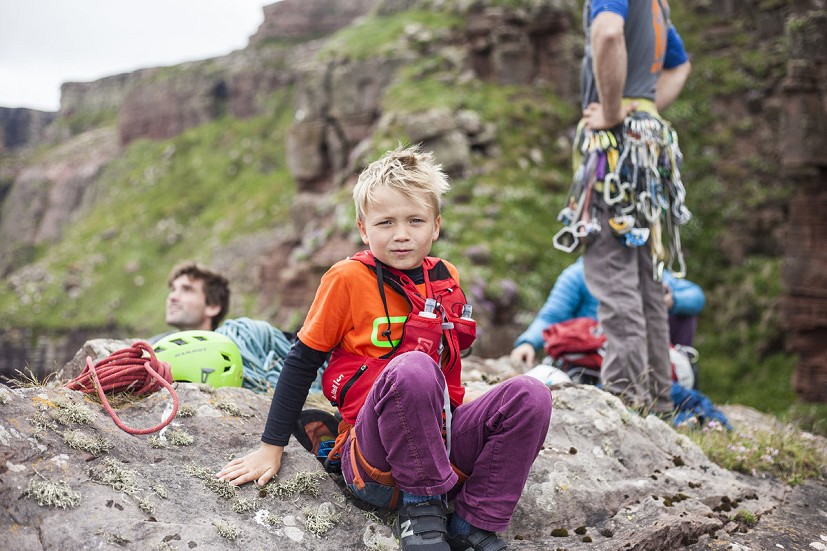

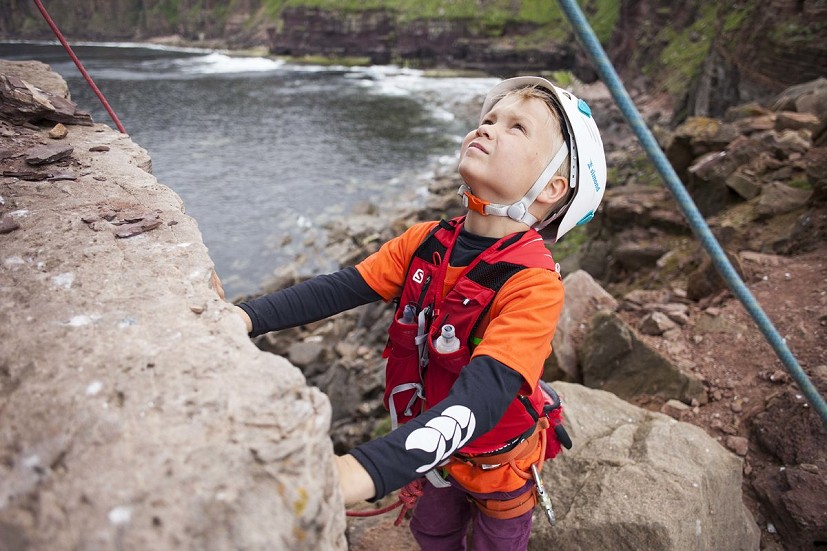

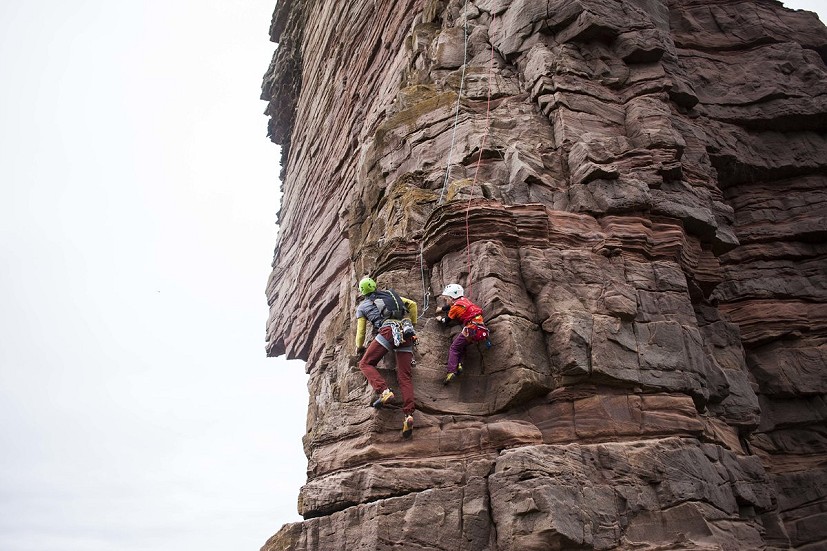
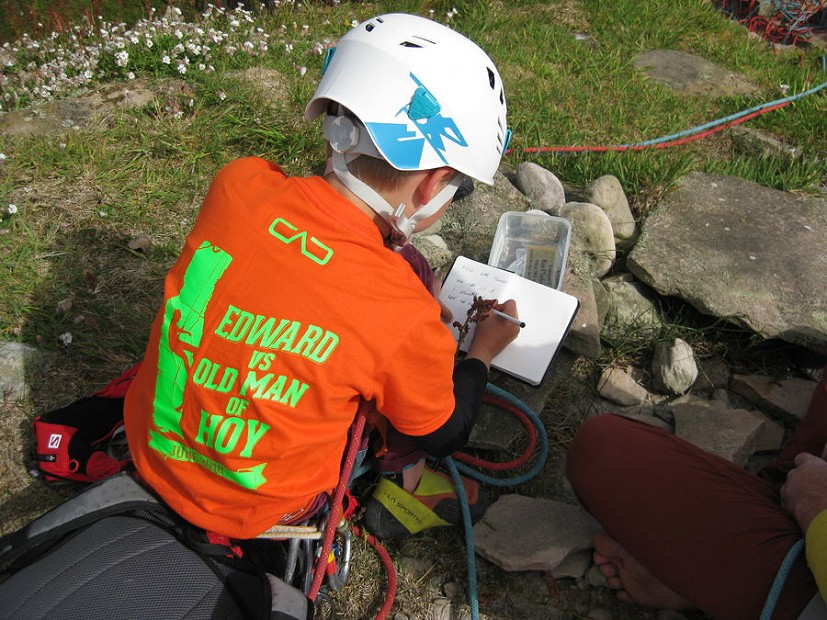
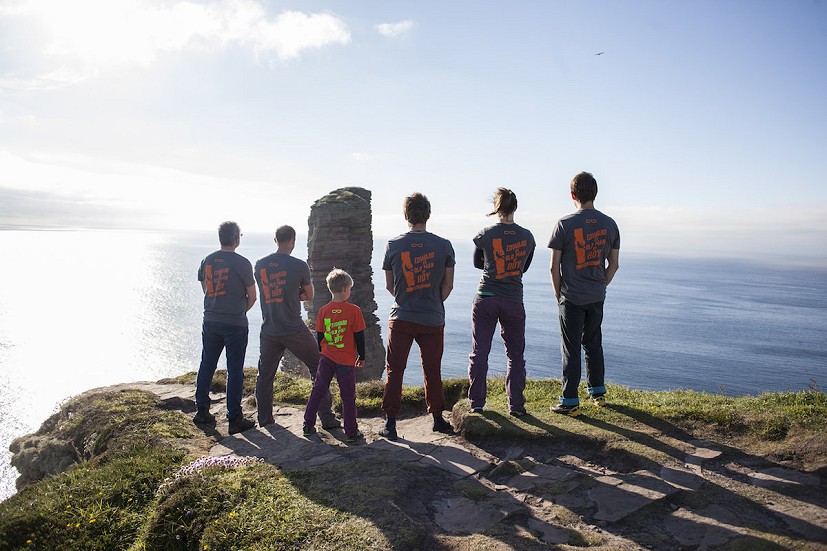
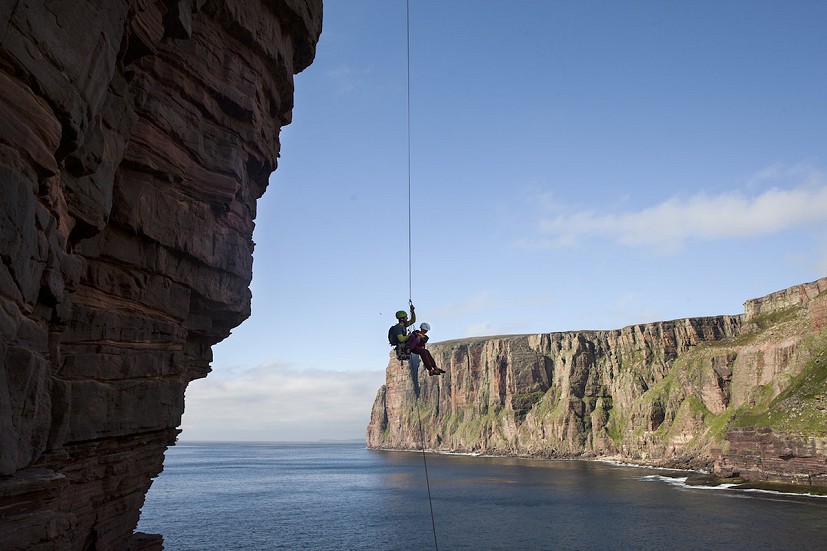
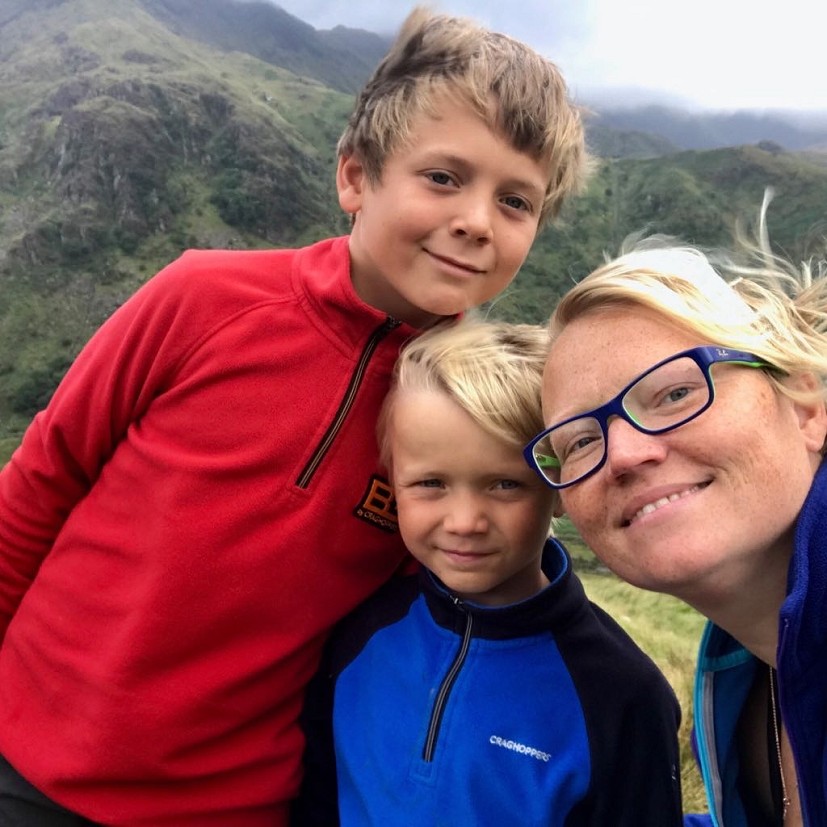
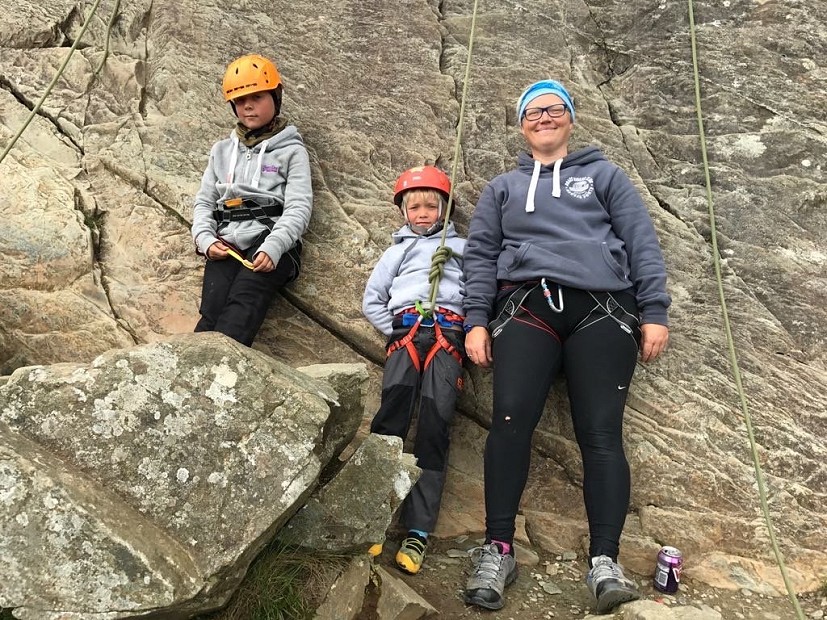
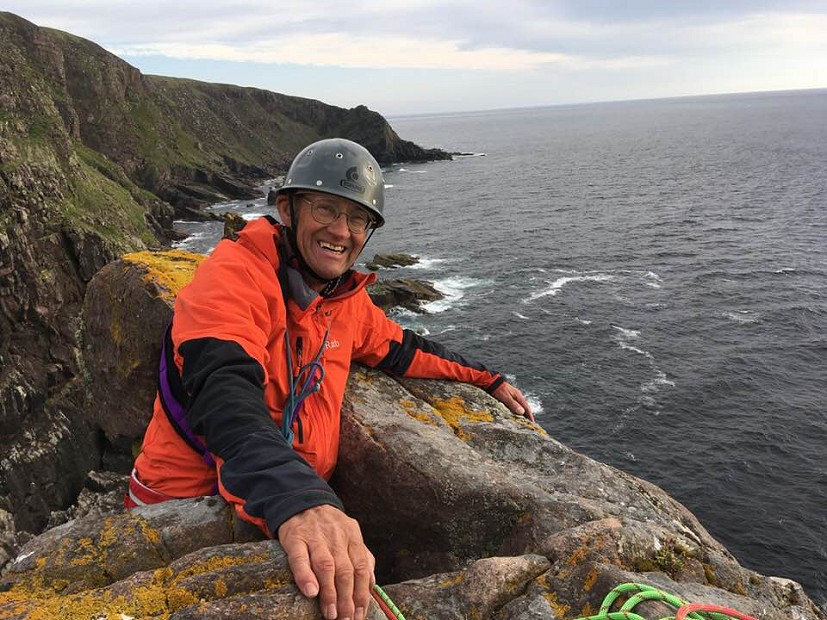
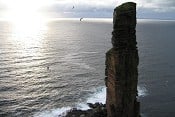
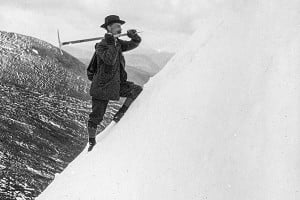

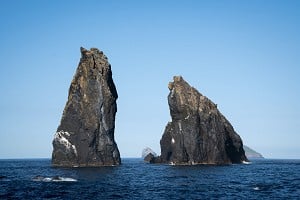
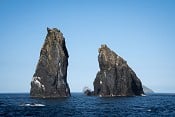








Comments
thanks for an excellent, inspiring article, and well done to both Edward and Tony! A great achievement, particularly by Edward, and it amazes me that anyone could have found anything negative to say about this (previous forum post). The other stacks should be a doddle after this.
On a side note, it looks like the logbook we left on the summit last year, after listening to Dave's accordion recital, has survived! I was sure it would blow away despite the duct tape.
A really touching article. Thanks.
These are great! More stories like them!